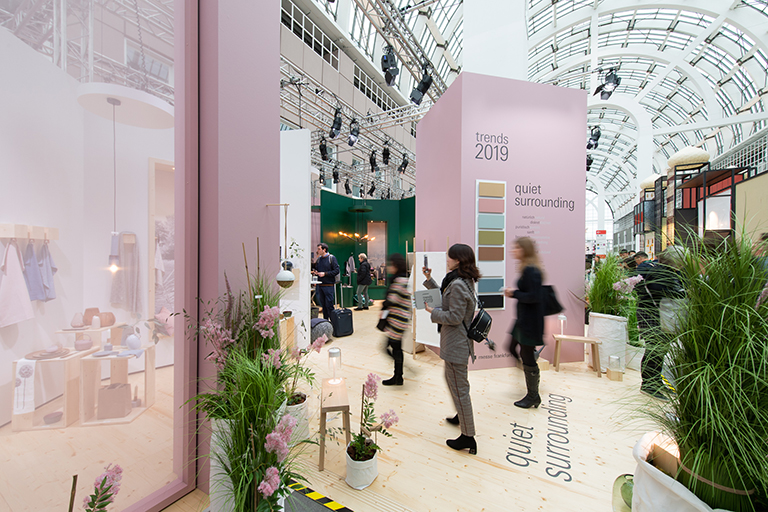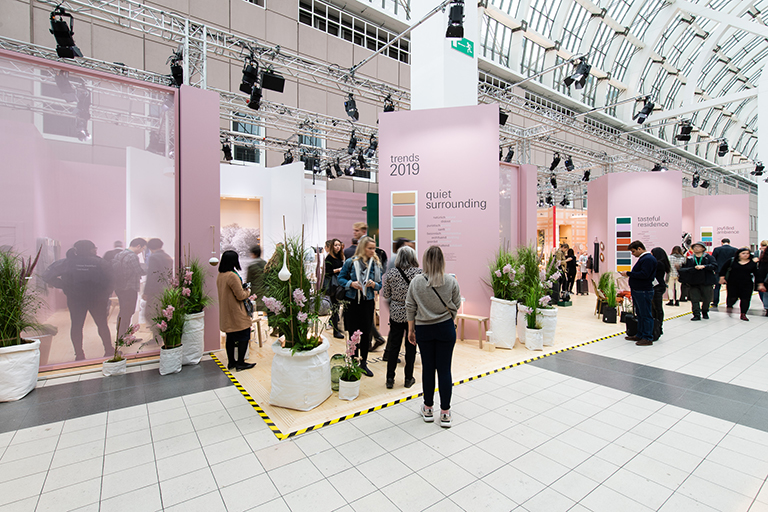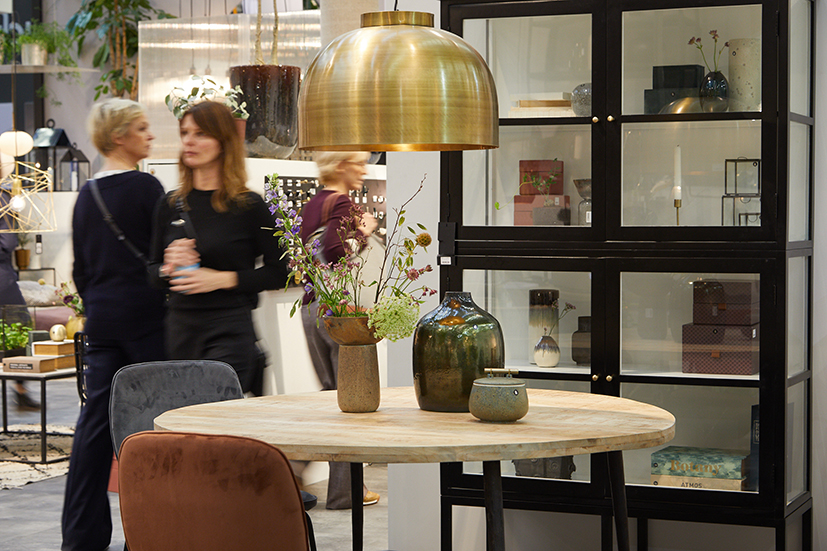ART4D SPEAKS WITH DIRECTOR GENERAL OF OSMEP FOLLOWING THE SUCCESS OF THAILAND’S PARTICIPATION AT THIS YEAR’S AMBIENTE
เมื่อช่วงต้นปีที่ผ่านมา งานแสดงสินค้าอุปโภคบริโภคระดับนานาชาติอย่าง “Ambiente 2019” (แอมเบียนเต้) ได้ถูกจัดขึ้นอีกครั้ง ณ เมืองแฟรงเฟิร์ต ประเทศเยอรมนี สินค้าที่มาจัดแสดงในงาน Ambiente 2019 นั้นจะถูกแบ่งออกเป็น 3 กลุ่มใหญ่ๆ ได้แก่ Dining ที่เน้นสินค้าที่เกี่ยวข้องกับการรับประทานอาหารและเครื่องครัว Giving ที่เน้นสินค้าเพื่อนำไปเป็นของขวัญ ของชำร่วยหรือเพื่อนำไปเป็นสินค้าส่งเสริมการขายต่างๆ และ Living ที่เน้นสินค้าเครื่องเรือนและของตกแต่งบ้าน โดยในแต่ละกลุ่มใหญ่ๆ นั้นยังถูกแบ่งเป็นสินค้าย่อยๆ อีกหลากหลายประเภท
ถึงแม้ภาพรวมของงานจะเน้นไปที่การให้ผู้ประกอบการในภาคอุตสาหกรรมจากหลากหลายประเทศทั่วโลกมาร่วมจัดแสดงสินค้าในหลากหลายหมวดหมู่ด้วยกัน แต่ภายในงานก็ยังมีพื้นที่สำหรับการนำเสนอแง่มุมของงานออกแบบและศิลปะอย่างเช่น ฟอรั่มต่างๆ พื้นที่สำหรับจัดแสดงผลงานของนักออกแบบรุ่นใหม่ นิทรรศการของก๊อปปี้จาก Aktion Plagiarius ซึ่งเป็นพิพิธภัณฑ์ที่รวบรวมข้อมูลของสินค้าก๊อปปี้หลากหลายเกรดที่บางชิ้นแทบจะหาความต่างจากแบรนด์ต้นแบบไม่เจอ พาวิลเลียนขององค์กรที่สนับสนุนด้านการออกแบบจากนานาประเทศไปจนถึงพื้นที่จัดแสดงนิทรรศการของ THE GERMAN DESIGN AWARD ที่ได้จัดแสดงผลงานที่ได้รางวัลสาขาต่างๆ ตั้งแต่การออกแบบบรรจุภัณฑ์ การออกแบบกราฟิก สิ่งพิมพ์ เฟอร์นิเจอร์ การออกแบบโปรดักท์ต่างๆ เทคโนโลยีการพัฒนาวัสดุเพื่อการก่อสร้างไปจนถึงผลงานด้านนวัตกรรมยานยนต์

Suwanchai Lohawatanakul, Director General of the Office of Small and Medium Enterprises Promotion (OSMEP)
แอมเบียนเต้ถือเป็นงานใหญ่ประจำปีของเยอรมนีที่ผู้ประกอบการในภาคอุตสาหกรรมต่างๆ ไม่ควรพลาดเพราะเป็นช่องทางในการขยายโอกาสทางธุรกิจของตัวเองสู่ตลาดระดับสากล หากใครได้มีโอกาสไปเข้าชมงานก็คงจะได้พบกับแบรนด์สินค้าหลายๆ แบรนด์ที่เป็นที่รู้จักจากเมืองไทยไปร่วมออกร้านจัดแสดงสินค้าที่งานนี้ด้วย ซึ่งทางหน่วยงานรัฐจากประเทศไทยอย่างสำนักงานส่งเสริมวิสาหกิจขนาดกลางและขนาดย่อม (สสว.) ก็ได้เห็นช่องทางการขยายโอกาสทางธุรกิจที่น่าจะเป็นประโยชน์กับผู้ประกอบการในไทย สุวรรณชัย โลหะวัฒนกุล (เสือ) ผู้อำนวยการสำนักงานส่งเสริมวิสาหกิจขนาดกลางและกลางและขนาดย่อม (สสว.) จึงได้สนับสนุนค่าใช้จ่ายในการเดินทางมาร่วมงานแอมเบียนเต้ให้กับผู้ประกอบการจำนวนหนึ่งที่เข้าร่วมโครงการกับทางหน่วยงาน
art4d: ช่วยเล่าถึงแนวคิดและกระบวนการทำงานที่เป็นที่มาของการเป็นผู้สนับสนุนให้กับผู้ประกอบการ ในการเดินทางมาร่วมงาน Ambiente ในครั้งนี้
Suwanchai Lohawatanakul: สสว. เป็นหน่วยงานหลักที่ดูแลธุรกิจ SME ทั้งประเทศโดยอยู่ภายใต้สำนักนายก โดยช่วงปีที่ผ่านมา ทาง สสว. เองก็พยายามออกแบบกระบวนการและวิธีการที่ส่งเสริมธุรกิจประเภท SME ให้แตกต่างไปโดยที่เราเน้นการพัฒนาในเชิงลึก เพราะที่ผ่านมาเราจะเห็นได้ว่าเรามีการพัฒนาธุรกิจประเภท SME มาระดับหนึ่ง ทีนี้จากโมเดลของปีที่แล้วที่เราได้ค้นพบ เรามองว่าถ้าเราจะยกระดับ SME ให้ออกไปสู่สากลได้เราจะต้องมีกลไกมาช่วยด้วยกันทั้งหมด 3 รูปแบบ อย่างแรกคือการปรับเปลี่ยนโมเดลธุรกิจให้ได้ อย่างที่สองคือการผลักดันสู่ตลาดสากลทั้งทางออนไลน์และ International trade กลไกสุดท้ายคือการสร้างเครือข่ายระหว่างผู้ประกอบการและเครือข่ายของนักวิชาการหรือที่ปรึกษา โดยปีที่ผ่านมาเราได้มีการตั้งรูปแบบของโมเดลธุรกิจไปแล้ว ปีนี้เราจึงเริ่มการนำาธุรกิจของ SME ไทยออกสู่สากลด้วยการสร้างความทันสมัยให้กับผลิตภัณฑ์และโมเดลธุรกิจเพื่อที่จะได้นำเอาความคิดสร้างสรรค์ต่างๆ ไม่ว่าจะด้านเทคโนโลยีหรือนวัตกรรมมาเป็นสิ่งเชื่อมต่อให้เกิด Value added ซึ่งจะเป็นตัวทำให้สินค้าขายได้มากขึ้น
เราได้มีการสร้างโมเดลธุรกิจด้วยการแบ่งกลุ่มธุรกิจออกเป็นหลายๆ กลุ่ม โดยกลุ่มแรกจะเป็นกลุ่มคนที่เริ่มทำธุรกิจใหม่เลยหรือกลุ่มคนที่ทำธุรกิจไม่เกินสามปี ซึ่งเรียกว่า SME start up หรือ early stage SME กลุ่มที่สองคือกลุ่มที่ทำธุรกิจไปเกินสามปีแล้วซึ่งเรียกว่ากลุ่ม Regular ซึ่งในกลุ่มนี้เองก็จะมีทั้งแบบธุรกิจที่เติบโต นั่นก็คือ Strong SME ส่วนอีกแบบคือแบบที่ถดถอยจะเรียกว่า Turn around คือหลักๆ เลยถ้าเรามองจากไซเคิลของรายได้เราก็จะพบว่าวิธีการสร้างโมเดลธุรกิจแต่ละแบบก็จะไม่เหมือนกัน ซึ่งสิ่งที่เราค้นพบก็คือเราสามารถเร่งจังหวะการโตได้ผ่านกระบวนการสร้างโมเดลธุรกิจที่ใช่และเหมาะสมกับรูปแบบ SME แต่ละกลุ่ม
The plagiarius award exhibition which exhibits counterfeit products to raise awareness about product development and brand protectionอย่างการที่พาผู้ประกอบการมางานแอมเบียนเต้เราก็มองว่ามันเป็นการทดสอบตลาด เราจำเป็นต้องสร้างหรือหาพื้นที่ใหม่ๆ ให้เหมาะกับ SME มากขึ้น โดยปีที่ผ่านมาเราได้ใช้กลไกนี้ไปทดลองตลาดที่ญี่ปุ่น โดยเราพาไปที่นางาซากิซึ่งเริ่มทดลองด้วยสินค้ากลุ่มอาหาร จุดประสงค์คือเราอยากให้ผู้ประกอบการเข้าใจความต้องการที่แท้จริงของผู้บริโภคให้มากขึ้น เรามีการจัดงานทั้งหมดด้วยกัน 3 วัน โดยที่วันสุดท้ายจบด้วย business matching ผู้ประกอบการที่ไปออกร้านในครั้งนั้น 15 รายจาก 20 รายขายของได้หมดภายใน 3 วัน สิ่งที่เกิดขึ้นในวัน business matching คือ trader ก็มีความมั่นใจทันทีเลยว่าสินค้าตัวไหนสามารถขายได้ กลไกแบบนี้จึงเป็นการทดสอบตลาด โดยการทดสอบตลาดก็มี 2 มิติ แบบแรกคือตลาดใหม่ที่ไม่เคยพาไปเลย เราจึงพาผู้ประกอบการไปทดลองเนื่องจากว่าผู้ประกอบการจะไปลงทุนเองก็เสี่ยง เราจึงไปทดลองให้ กับแบบที่สองคือตลาดที่เคยดีในอดีตแต่มีแค่ผู้ประกอบการรายใหญ่ในตลาด รายเล็กจึงไม่มีโอกาสไปเพราะค่าใช้จ่ายสูง ค่าเดินทางแพง ซึ่ง สสว. เองก็มีเกณฑ์การช่วยเหลือได้ไม่ถึง 100 เปอร์เซ็นต์ คือเราสามารถช่วยเหลือได้ 60 เปอร์เซ็นต์ โดยที่เหลือผู้ประกอบการก็ต้องช่วยเหลือตัวเอง สุดท้ายมันก็เลยเกิดเป็นงานนี้ขึ้นมาคือการพามาที่แอมเบียนเต้ เพราะปีนี้เราโฟกัสที่สินค้ากลุ่มอาหารและไลฟ์สไตล์ ซึ่งกลุ่มไลฟ์สไตล์ก็มีตั้งแต่สินค้าประเภทแฟชั่น ไลฟ์สไตล์โปรดักท์ ของตกแต่งบ้าน ซึ่งสินค้าสองประเภทหลังนี้ค่อนข้างจะเป็นสินค้าที่โดดเด่น และอีกเรื่องหนึ่งที่เราเน้นคือการทดสอบตลาดดังนั้นการทำการตลาดจึงเป็นปลายทางของการส่งเสริมทั้งหมด โดย สสว. นั้นเน้นที่การทำางานเชิงลึก ซึ่งการที่จะไปถึงตรงนั้นได้ SME เองก็ต้องกล้าเปลี่ยนแปลงตัวเองด้วย เพราะอย่างแอมเบียนเต้ นี่ก็คือการพามาครั้งแรกโดยมาทดสอบตลาดใหม่ก่อน เราก็แจ้งผู้ประกอบการไปเลยว่าเราพามาลองเสี่ยง โดยการมาในครั้งนี้เราก็สนับสนุนทั้งเรื่องเงินและองค์ความรู้

‘Starry Night Café,’ sitting area designed by Sandeep Sangaru from India, which is the partner country of Ambiente 2019
art4d: ฟังดูเหมือนกระบวนการทำงานจะมุ่งเน้นไปที่เรื่องของการทดสอบตลาดหรือการพาผู้ประกอบการออกไปหาช่องทางใหม่ๆ เสียเป็นส่วนใหญ่ อยากทราบว่าทาง สสว. มีนโยบายที่จะมุ่งเน้นการพัฒนาไปที่ตัวผลิตภัณฑ์แบบจริงจังเลยหรือไม่ อย่างเช่นโมเดลการจับคู่ผู้ประกอบการกับนักออกแบบสาขาต่างๆ เพื่อร่วมมือกันพัฒนาโปรดักท์ให้มีคุณค่าและตอบโจททย์ของตลาดในแต่ละกลุ่มอย่างจริงจัง
SL: อย่างถ้าเป็นกลุ่มที่เป็น creative economy ทาง สสว. มองเป็นเชิงลึกของอุตสาหกรรม ทีนี้เรามามองว่า creative economy มันมีอะไรบ้าง อย่างแฟชั่นก็ถือเป็นอย่างหนึ่ง โดยโจทย์ที่เรากำลังเล่นอยู่ตอนนี้ก็คือการนำเอาดีไซเนอร์รุ่นใหม่มาเจอกับ value chain ก่อให้เกิดผลิตภัณฑ์ปลายทางซึ่งตอนนี้กำลังอยู่ในขั้นตอนการพัฒนาโดยคาดว่าปีนี้น่าจะพาไปตลาดฮ่องกง ซึ่งเส้นทางที่นำไปสู่ความสำเร็จก็มีหลายรูปแบบ อย่างเช่นดีไซเนอร์ที่อยากจะไปเจอหรือทำงานกับผู้ประกอบการ หรือผู้ประกอบการที่อยากจะมีความครีเอทีฟ หรือการนำดีไซเนอร์หนึ่งคนกับผู้ประกอบการหนึ่งคนมาเจอกัน โดยเราก็ต้องเข้าไปดูตามความเป็นจริง แต่ในการสร้างความสำเร็จทางเราเองก็ไม่ได้แค่มองว่าการเอาคนมาเจอกันนั้นคือความสำเร็จ แต่เราต้องวาง eco system ให้เขาด้วย ตั้งแต่วัตถุดิบไปจนถึงองค์ความรู้ด้านต่างๆ หรือแม้กระทั่งกระบวนการผลิตซึ่งอาจจะเป็นปัญหาของนักออกแบบรุ่นใหม่ เช่น นักออกแบบรุ่นใหม่อาจจะมีไอเดียดีแต่ผลิตไม่ได้เพราะไม่มีโรงงาน เราก็จะสร้างลิสต์ของ OEM ให้ เพื่อเป็นการสานต่อให้น้องๆ สร้างธุรกิจให้เกิดได้เร็วขึ้น ซึ่งการออกแบบในรูปแบบนี้เป็นการออกแบบเชิงลึกที่ทาง สสว. ปรับมิติอย่างสิ้นเชิง เพราะเรามีหน้าที่สร้างผู้ประกอบการ ทำให้เค้ากล้าเริ่ม กล้าล้ม กล้าสำเร็จ กล้าเติบโต โดยแต่ละคนก็จะใช้วิธีการไม่เหมือนกัน สิ่งที่สำคัญที่สุดคือการกล้าเริ่ม เพราะตราบใดที่ธุรกิจได้เริ่มแล้วจิตวิญญาณของผู้ประกอบการมันจะมาเอง มันจะมีการเชื่อมต่อของคนกลุ่มหนึ่งไปสู่อีกกลุ่มหนึ่งโดยปริยาย ซึ่งถือเป็นสิ่งที่ดีที่สุดของ SME
ถึงแม้ว่าการพาผู้ประกอบการมาร่วมงาน Ambiente 2019 ที่ผ่านมานั้น จะเป็นเพียงการพามาทดสอบตลาดและยังไม่ใช่บทสรุปของความสำเร็จในการประกอบธุรกิจ แต่เราเชื่อว่าการที่มีหน่วยงานจากภาครัฐเห็นความสำคัญของผู้ประกอบการขนาดเล็กและหยิบยื่นโอกาสในการเข้าร่วมทดลองตลาดในงานระดับนานาชาติให้นั้นถือเป็นเรื่องน่ายินดีและมีความสำคัญต่อการพัฒนาเศรษฐกิจให้ขับเคลื่อนไปในทิศทางที่ถูกควร เพราะท้ายที่สุดแล้วการที่ระบบเศรษฐกิจจะขับเคลื่อนไปได้อย่างยั่งยืนนั้นคำตอบอาจจะยังไม่ใช่แค่การหยิบยื่นช่องทางและโอกาสให้กับผู้ประกอบการรายใหญ่ที่มีอยู่เพียงไม่กี่เจ้า หากแต่เป็นการกระจายโอกาส ช่องทางทางธุรกิจ และรายได้ให้ไปถึงผู้ประกอบการขนาดอื่นๆ ในทุกภาคส่วน

Ambiente 2019 took place earlier this year, as always in Frankfurt, Germany. The prominent international consumer goods fair is organized into three separate product categories and several other subcategories: Dining (tableware, kitchenware, and household items), Giving (a mixture of lifestyle products including gift items, decorative and personal accessories, bags and jewelry etc.), and Living (interior design, furnishings, and decor). While the event mostly focuses on bringing together entrepreneurs from the creative sector from around the world to meet and showcase their products, it also features a platform for art and design forums, as well as exhibition spaces for young and emerging designers, including an exhibition by Akiton Plagiarus, a museum that brings together vast collections of counterfeit products and audacious examples of plagiarism, some with details so perfectly copied that one can barely tell they’re fake. Also exhibiting are pavilions by design organizations from all around the globe, as well as an exhibition by THE GERMAN DESIGN AWARD, which features winning projects from different categories such as communication design, packaging design, editorial design, product design, furniture, construction material development technology, and automotive innovation.
Ambiente is one of Germany’s biggest annual events where entrepreneurs from different industries have the chance to reach potential buyers and investors worldwide. Visitors are able to see an incredibly wide range of products by brands from all around the world, including Thailand. Realizing that it offers potential business opportunities to Thai entrepreneurs, The Office of Small and Medium Enterprises Promotion (OSMEP), led by Director Suwanchai Lohawatanakul, offers financial support for a select number of entrepreneurs to travel to Frankfurt and participate in Ambiente 2019.

The exhibition of the German Design Award 2019
art4d: Could you explain the idea and process of OSMEP’s sponsorship offered to Thai entrepreneurs for this year’s Ambiente?
Suwanchai Lohawatanakul: The Office of Small and Medium Enterprises Promotion (OSMEP) is the key agency that oversees the entire SME business in Thailand, and we operate under the Prime Minister’s Office. This past year, we have been trying to design a different process and methodology to promote SME business, and to develop an in-depth approach to the development. We have witnessed a certain level of progress, but what we learned from last year’s model is that if we were going to bring our SME entrepreneurs onto the world stage, there are three mechanisms that must be involved. The first is to do with changing the business model, the second is to push the brands and products through online platforms and international trade fairs, and the third is to build and expand a network of entrepreneurs and academics as well as experts and consultants. This past year, we have managed to develop a business model, so this year is going to be about bringing Thai SME businesses to the international market. The products and business models have been modernized so that we are able to incorporate different aspects of creativity, whether it be technology or innovation that creates added value which ultimately allows the products to be more commercially successful.
We create business models by categorizing entrepreneurs into groups of SME startups (newly operating entrepreneurs), and the regular (entrepreneurs who have been operating for less than three years). Within this group, there are those that fall into the Strong SME group, and those that fall into the Turn around SME group. Mainly, if we look at these SMEs cycle of the income, we find that there are different methods to develop business models, and we are able to stimulate growth through the right business model that suits the natures of the different SME groups.

‘Talents,’ the exhibition space for young designers at Ambiente 2019
We sponsor these entrepreneurs because we think it’s a way for us to test the market; new platforms that are better fitting with our SMEs. We’ve tried this model in the Japanese market, and we took a group of entrepreneurs to Nagasaki where they introduced products for the food and beverage industry. Our objective was for the entrepreneurs to have a true understanding about the demands of today’s consumers. The event took place over three days, the last day being the business matching day, and it resulted in 15 out of 20 of the entrepreneurs selling out of their products within the three days of the fair. What happened on business trading day was the exhibitors became immediately confident in their products. They knew which would sell. This type of mechanism allows us to test the market more effectively. We gathered two key insights from this experience. The first one is, baring in mind that the market is completely new to us, that the sponsorship was given only to entrepreneurs that we think have enough potential. Also because the market could be risky for them to start investing in something, that’s where we step in. Then there’s the good market, which has been monopolized by big entrepreneurs, and that automatically eliminates any chance for SMEs because the demand for investment would be too high and the logistical fees would be too expensive. OSMEP couldn’t really provide 100% support. We offer to cover up to 60% of the expenses and the rest is the entrepreneurs’ own responsibility. We initiated the project at Ambiente because this year we’re putting our focus on food, and lifestyle products ranging from fashion to home decoration. The latter is the product group with greatest potential to be commercially successful. And since one of our objectives is to test the market, having well developed marketing strategies is likely the purpose of all these promotions. OSMEP places its emphasis on developing business operations that are both comprehensive and in-depth, and on enabling SMEs to have the courage to change. Helping these entrepreneurs participate in Ambiente for the first time is like testing a new market, and we informed them in advance that this is a test and there will be risks, but we do provide the financial support and know-how.
‘Ambiente Trends 2019,’ the exhibition space that presents future trends among appliances and decorationsart4d: It seems that the work process focuses on market testing and helping entrepreneurs to explore new possible distribution channels. Does OSMEP have any policies to help these entrepreneurs in the development of their products, for instance, in pairing entrepreneurs with designers from different fields to create products of higher quality and effectively meet the demands of different target markets?
SL: For creative economy products, there’s a deeper aspect of consideration about how they are viewed and handled. For example, fashion is also a part of the creative economy, so the challenge we’re dealing with is bringing together young designers and including them in the value chain, which results in the way that the final products are conceived and developed. We’re currently in the development stage and we’re planning to introduce some of the brands in the Hong Kong market. There are different paths to success. There are designers who want to meet or work with entrepreneurs, and there are entrepreneurs who wish to work more creatively through collaboration with designers. To successfully pair a designer with an entrepreneur, we have to look at the facts and reality. We don’t think that just by pairing them up, they will automatically be successful, because there has to be an ecosystem for them, influencing a range of factors such as access to raw materials and know-how. Even the production process is a big problem for young designers nowadays because they have all these great ideas but they can’t bring them into reality because they don’t have access to the right production base. We’re planning to create a list of OEM providers to help these young designers pursue their goals, and to develop the kind of business they want faster. It’s an in-depth approach, which requires us to adjust our mindset a great deal, as well as the way we operate, because our job is to create entrepreneurs, and to make them courageous enough to take on initiatives, and to grow out of failure. Each of them has a different approach, but the most important thing is to have the courage to start because as long as the business has begun, the entrepreneur’s spirit will eventually ensue. And there’s always a connection between one group and another that’s being formed and expanded; that’s the best thing about SMEs.
While this participation in Ambiente 2019 is only to test the market, and isn’t exactly the conclusion of how their business operation should be carried out, we do believe that having a government agency to support them, which recognizes the importance of SMEs enough to provide them the chance to be a part of an international trade show, is promising progress. It will greatly contribute to the development of the country’s economy, along the direction it should be heading in. At the end of the day, for the economy to grow sustainably, the answer is perhaps not just about creating opportunities and paving the way for a few entrepreneurs, but more about distributing business opportunities and income to other entrepreneurs of all scales, and from all sectors.







